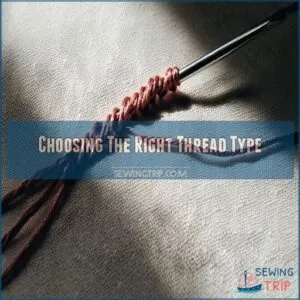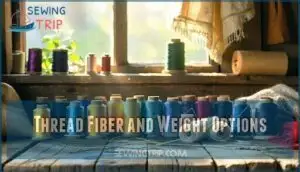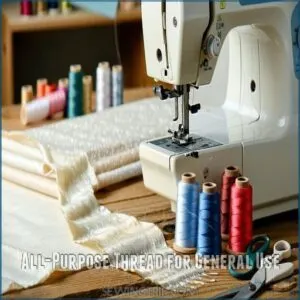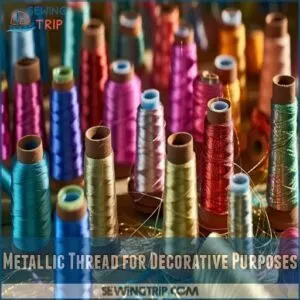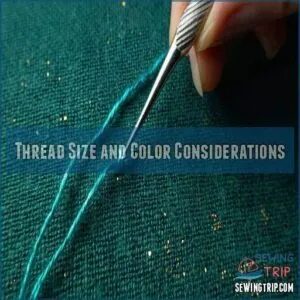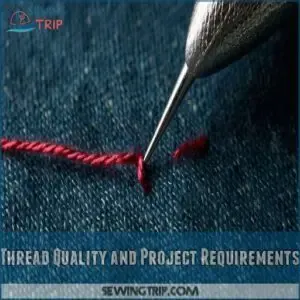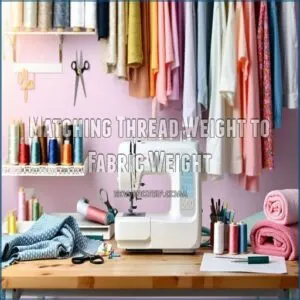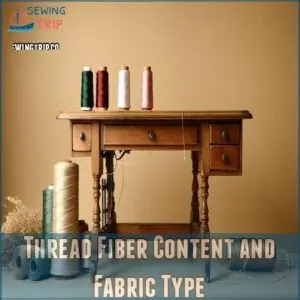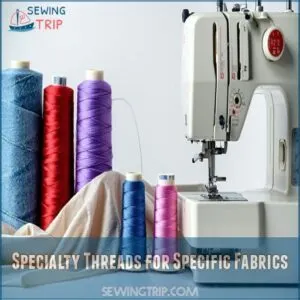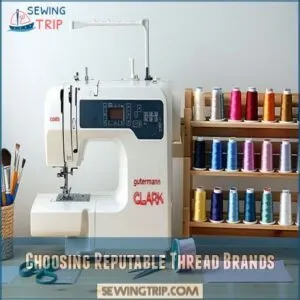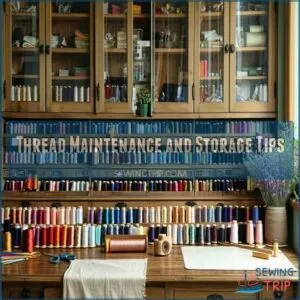This site is supported by our readers. We may earn a commission, at no cost to you, if you purchase through links.
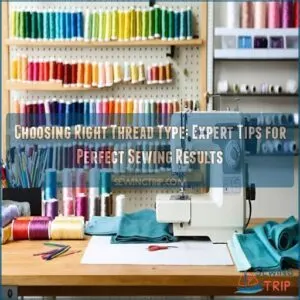
Start by matching the thread’s weight to your fabric—lighter threads for delicate fabrics, heavier ones for sturdy materials.
Cotton thread pairs beautifully with natural fabrics like linen, while polyester’s flexibility suits most projects. For heavy-duty fabrics like upholstery, nylon is your best friend.
Don’t overlook thread color—it’s often best to go a shade darker for blending or choose a bold contrast for a pop of detail. And always use quality brands like Gutermann for smooth, strong stitches.
Want more specifics to nail your next project? Keep these essentials handy!
Table Of Contents
Key Takeaways
- Match thread weight to fabric weight for smooth sewing and avoid snaps—lighter threads for delicate materials and heavier ones for sturdy fabrics.
- Choose thread fiber based on fabric type—use cotton for natural fabrics, polyester for versatility, and nylon for heavy-duty projects.
- Prioritize thread color and test it on fabric scraps—go darker for blending or pick contrasting colors for bold details.
- Opt for high-quality thread brands like Gutermann to ensure durability and prevent breakage mid-project.
Choosing The Right Thread Type
Choosing the right thread type is essential for strong, professional-looking stitches that last.
You’ll want to match the thread’s weight, fiber, and properties to your fabric to guarantee smooth sewing and a flawless finish.
Matching Thread With Fabric Weight
Thread weight options play a huge role in fabric compatibility. For light fabrics like chiffon, go with a finer thread around 60wt.
Heavy materials, like denim, need thicker threads for durability. Always test your thread on a fabric scrap to check strength and fit.
Matching thread weight promotes smoother sewing and avoids unwanted snaps mid-project, saving tons of frustration.
Considerations for Thread Fiber Content
When picking the right thread fiber, think about fabric compatibility and durability.
Natural fibers like cotton pair well with breathable fabrics, while synthetic fibers such as polyester thrive on strength and flexibility.
Specialty fibers, like silk, shine on delicate textiles.
Fiber blends often balance performance needs, ensuring fabric suitability for your project.
Match thread fiber types wisely for flawless results and consider the performance needs of your project.
Thread Size and Color Selection
Your fabric’s weight influences thread size. Thicker fabrics need heavier threads, while lighter materials pair with finer ones.
Thread Size Charts can guide you.
For colors, hold the strand to your fabric—Color Matching Techniques say go a shade darker if unsure.
High-quality brands like Gutermann guarantee Thread Finish Options stay consistent. Trust the process, not guesswork!
Choosing The Right Thread Color
Picking the perfect thread color can make or break a sewing project. Aim for harmony and balance with these tips:
- Match the fabric shade for a seamless look.
- Choose a slightly darker shade if unsure—it blends better.
- Contrast boldly for visual impact.
- Test the color on fabric scraps first.
- Blend complementary tones for artistic flair.
When selecting a thread, consider the types of thread suitable for your fabric to guarantee a professional finish.
Thread Fiber and Weight Options
Choosing the right thread fiber and weight is essential for achieving strong, smooth seams.
With so many options like cotton, polyester, and nylon, understanding their strengths helps you pick what works best for your fabric and project.
Cotton Thread for Natural Fabrics
Cotton thread shines with its durability and perfect pairing with natural fabrics like cotton or linen.
Its breathability enhances fabric softness, making it ideal for comfy projects.
Plus, cotton thread types perform well under heat, so no need to worry about shrinking during ironing.
A proper thread weight is essential for quality stitches on cotton fabric. Keep your sewing machine clean, though—lint buildup can be a pesky side effect!
Polyester Thread for Versatility
If natural fabrics call for cotton, polyester thread shines everywhere else. Known for its strength, elasticity, and color variety, it’s perfect for versatile sewing applications.
Polyester threads handle tough jobs without breaking a sweat. When selecting the right thread, consider Polyester Thread Properties.
Polyester threads handle tough jobs without breaking a sweat.
- Durable: Resists sunlight, mildew, and chemicals.
- Versatile: Works with most fabrics.
- Varied Finishes: Mimics cotton or silk.
- Economical: Longer-lasting.
- Strong Options: Ideal for upholstery or outdoor projects.
Nylon Thread for Heavy Fabrics
Nylon thread is your go-to for heavy fabric projects like upholstery, leather, or canvas.
Its durability and abrasion resistance make it perfect for thick fabrics.
Bonded nylon adds extra strength for heavy-duty threads, preventing breakage during sewing.
Plus, its compatibility with synthetic fabrics and flexibility under pressure make it a reliable thread for thick fabrics in tough jobs, with heavy-duty threads being a notable example.
All-Purpose Thread for General Use
All-purpose thread is your go-to for everyday sewing essentials, handling most fabrics with ease.
Made from polyester or a cotton-poly blend, it’s tough and versatile.
Here’s why it’s a top choice:
- Works with natural and synthetic fabrics. Offers good thread longevity factors. Perfect for general sewing needs.
- A wide range of colors available. Simplifies thread and fabric pairing.
Metallic Thread for Decorative Purposes
Metallic thread adds a stunning shimmer to your projects, perfect for decorative stitching techniques and embellishment ideas.
Its shiny texture elevates any design, but these threads can be tricky to handle. Pair them with embroidery thread or lighter thread types for sewing ease.
Always test compatibility and thread color selection on scraps to verify the perfect balance of sparkle and durability.
Using high-quality Metallic Embroidery Thread can make a significant difference in the final appearance of your project.
Thread Size and Color Considerations
Choosing the right thread size and color is key to achieving professional-looking sewing results.
You’ll want to match thread thickness to your fabric type.
You’ll want to find a color that either blends seamlessly or adds just the right contrast with professional-looking sewing results.
Matching thread thickness to your fabric type is crucial for a seamless finish.
Selecting Thread Size for Fabric Type
Picking the right thread size for your fabric is like finding the perfect teammate. Too thick, and it overwhelms; too thin, and it snaps.
Use a thread weight guide to match fabric weight.
- Light fabrics: Opt for finer threads (60wt).
- Medium fabrics: Standard 50wt works.
- Heavy fabrics: Choose thicker threads (30wt).
- Stretchy fabrics: Elastic thread offers flexibility.
Choosing Thread Color for Solid and Patterned Fabrics
Matching thread color to fabric depends on fabric background considerations and tonal harmony principles. For solids, opt for thread hues slightly darker for blending.
Solid colors have specific thread matching guidelines. For Solid Light Color, use the same or a darker tone, opting for a hue that is slightly darker. This allows the seam to blend naturally.
Solid Dark Color fabrics call for a lighter or matching thread tone, resulting in a seam that is subtly visible with a slightly lighter hue.
Patterns, on the other hand, require smart thread selection. For Floral Patterns, match the background fabric with a neutral or background tone to achieve a balanced and cohesive look.
For Bold Prints, match the dominant shade with a vibrant or contrasting hue to create high-impact visual interest.
Use this thread selection guide to determine the best thread color for your fabric type:
| Fabric Type | Thread Style | Recommended Hue | Effect |
|---|---|---|---|
| Solid Light Color | Same or darker tone | Slightly Darker | Seam blends naturally |
| Solid Dark Color | Lighter or matching | Slightly Lighter | Seam subtly visible |
| Floral Patterns | Match background fabric | Neutral/Background Tone | Balanced and cohesive look |
| Bold Prints | Match dominant shade | Vibrant/Contrasting Hue | High-impact visual interest |
Thread Color and Fabric Compatibility
Thread color and fabric compatibility are essential for polished results. Follow these tips for harmony:
- Color Harmony Guidelines: Blend thread with fabric for seamless results.
- Neutral Thread Options: Use grays or beiges when matching depth is tricky.
- Fabric Grain Considerations: Test thread direction for subtle shifts in appearance.
- Monochromatic Schemes: Stick to similar hues for natural fibers or synthetic blends.
Smart choices enhance projects effortlessly!
High-Contrast Thread Color for Visual Interest
Highlighting your stitches with bold thread choices can transform a project.
Using Visual Contrast Techniques, like pairing dark fabric with a bright topstitching thread, creates eye-catching designs.
For added flair, try Color Blocking Effects or Metallic Thread.
Choosing the right thread type with contrasting Tonal Value Contrast makes certain your stitches stand out beautifully, showcasing your skill and creativity.
Mastering thread color matching requires understanding Thread Color Systems to achieve perfect embroidery results.
Thread Quality and Project Requirements
Choosing the right thread quality guarantees your stitches are strong, smooth, and built to last.
You’ll also want to match the thread’s strength and flexibility to your project’s specific fabric and purpose for the best results, ensuring that your stitches are built to last.
Thread Quality and Consistency
Ensuring thread quality and consistency makes projects look sharp and last longer.
Here’s how to check thread durability by gently tugging it for strength.
Perform colorfastness testing to prevent fading or bleeding.
Avoid thread breakage by inspecting for smooth, even fibers.
Use thread weight charts to match fabric and maintain stitch integrity.
- Look for thread durability by gently tugging it for strength.
- Perform colorfastness testing to prevent fading or bleeding.
- Avoid thread breakage by inspecting for smooth, even fibers.
- Use thread weight charts to match fabric and maintain stitch integrity.
Thread Weight and Fabric Compatibility
When picking thread weight, always consider fabric weight. Lightweight fabrics need fine threads, while heavy fabrics call for thicker ones. Skipping this step can lead to thread breakage or tension issues.
Fabric Stretch Compatibility matters too—avoid stiff threads for stretchy fabrics.
Matching thread selection to fabric type and size guarantees smooth stitching and prevents stretch limits from being tested.
Project Type and Thread Requirements
Your project type determines thread requirements.
For stretchy fabrics, choose elastic threads to maintain fabric stretch. Heavy fabrics like denim demand threads with extra strength for durability.
Want your stitches to pop? Prioritize thread visibility with bold colors.
And remember, thread texture impacts performance—smooth threads handle fast sewing speeds better, while rougher threads may manage slower setups.
Sewability and Thread Functionality
Sewability impacts whether your project flows smoothly or falls apart.
Thread performance metrics like durability, tension control, and yarn construction directly influence sewing results.
Poorly matched threads can cause skipped stitches or uneven seams.
- Test Fabric Thread Interactions: Stitch a scrap first.
- Balance Thread Type Selection: Match thread weight to fabric.
- Check Sewing Thread Durability: Avoid breaks mid-project.
Thread Selection and Fabric Compatibility
Choosing the right thread for your fabric is key to achieving strong, smooth stitches.
Matching thread weight and fiber content to your fabric guarantees your projects appear professional and hold up over time.
Matching Thread Weight to Fabric Weight
The wrong thread weight can turn a promising project into a headache.
Match lightweight thread to delicate fabrics and thicker thread to heavier materials for even, strong seams.
Think of thread balance techniques as pairing shoes to an outfit—everything just clicks.
A thread weight guide or thread size chart helps guarantee fabric density effects don’t throw you off.
Thread Fiber Content and Fabric Type
Understanding thread fiber content is key to pairing it with the right fabric type.
Natural fiber threads like cotton work best with natural fabrics, offering breathability and softness. Polyester threads suit synthetic blends due to their strength and flexibility.
Always test fabric-thread tension and use thread durability tests to guarantee compatibility. Matching fiber content guarantees strong, smooth seams every time.
Specialty Threads for Specific Fabrics
Not all threads are one-size-fits-all. Specialty threads make a difference when sewing specific fabrics.
- Use elastic thread for stretch fabrics like knits and activewear.
- Choose heavy-duty thread for thick materials like denim, leather, or upholstery.
- Lightweight fabrics like silk or lace pair best with lingerie thread for soft, seamless stitching.
Considering the Thread Selection Basics will guarantee that you match the right thread weight to your fabric type for the best results.
Fabric thread compatibility matters for perfect results!
Choosing Reputable Thread Brands
Picking trusted thread brands keeps your projects stress-free.
Look for names like Gutermann or Coats & Clark—they’re known for consistent quality. Check reviews, watch for strong reputation, and look into durability tests.
Using reliable brands means fewer headaches mid-stitch.
You can also find Coats & Clark thread products online sewing supplies.
Here’s a quick guide:
| Factor | What to Look For |
|---|---|
| Brand Reputation | Established sewing brands |
| Quality Control | Smooth, even thread |
| Durability Tests | Reviews from users |
| Customer Feedback | Positives outweigh negatives |
| Thread Assurance | Warranties or guarantees |
Thread Maintenance and Storage Tips
Keeping your threads in top condition starts with proper storage and care. Store them in a cool, dry place to prevent fading, brittleness, or breakage over time.
Storing Threads for Long-Term Use
Proper thread storage guarantees they’re ready when you are.
Keep your threads vibrant and functional by following these steps:
- Choose airtight containers to shield spools from dust.
- Store in a cool, dry place to control humidity and extend thread shelf life.
- Prevent fading with protective covers against sunlight.
- Organize spools smartly to avoid unwinding during storage.
Preventing Thread Disintegration
Keeping threads in top condition takes effort but pays off in longer-lasting results.
Store spools in a cool, dry space, away from UV rays, to avoid fading or brittleness. Skip plastic bags—they trap moisture. Embrace thread storage solutions like sealed containers for humidity control.
Regularly inspect for damage—early fixes preserve thread quality and prevent frustrating disintegration.
Rotating Older Threads for Best Results
Old threads mightn’t seem outdated, but they’ve got their limits.
Regularly check for thread degradation signs like brittleness or fading. Incorporate thread inventory management into your routine to catch expiring spools.
Rotate older threads to the front of your thread storage solutions and prioritize their use.
This thread care method guarantees thread longevity, storage efficiency, and better project results.
Proper Thread Care and Handling
To keep your thread in top shape, store it in a cool, dry spot away from sunlight—humidity can ruin its shelf life. Using a sewing embroidery thread storage system can also help maintain thread quality.
Use clear containers for spool management and tangle prevention, making thread care simple. Rotate older threads to guarantee longevity, and for quick thread revival, try gentle rewinding.
These thread storage tips promise smoother sewing every time, with proper thread care.
Frequently Asked Questions (FAQs)
How do I choose the right thread?
Don’t stress about thread choice—it’s simpler than it seems.
Match thread type to your fabric: cotton for natural fibers, polyester for durability, or nylon for stretch.
Always test weight and color first!
How do I choose the best sewing thread?
Pick a thread that matches your fabric’s weight and purpose.
Cotton works great for natural fabrics; polyester handles most projects.
Test color on scraps first, and go for quality brands to prevent breakage.
How do I choose the right thread size for my project?
Choosing thread size feels like finding the right key for a lock—it must fit perfectly.
Use thinner threads (60wt) for delicate fabrics and thicker ones (40wt or lower) for heavier materials like denim or canvas.
How do I choose the best thread strength?
Match thread strength to your fabric and project needs.
For lightweight fabrics, go with standard strength. Heavy fabrics or seams need heavy-duty thread.
Always test on a scrap first to avoid breaks.
How do you choose a fabric thread?
Don’t put the cart before the horse—trust the fabric first.
Match strong polyester to synthetics, soft cotton thread to natural fibers, and heavier thread to thick fabrics.
Testing on scraps guarantees perfect stitching every time.
How do I choose the right thread color?
Pick a thread color that blends with your fabric by laying a strand across it.
If an exact match is tricky, go slightly darker.
For bold designs, contrasting or variegated threads add fun visual effects.
How do you prevent thread tangling issues?
Thread tangles are like a bad hair day—prevent them by using quality thread and threading correctly.
Adjusting tension is also essential in preventing thread tangles.
Clean the machine regularly to maintain its performance.
Use a matching needle and keep spools smooth by trimming loose thread ends.
What thread works best for hand stitching?
For hand stitching, you’ll want a strong, smooth cotton or polyester thread.
Cotton works well for natural fabrics.
Polyester handles most materials.
Avoid heavy-duty threads—they’re bulky and harder to work with by hand.
How can you identify old or weak thread?
Picture a thread that snaps with a gentle tug or feels brittle in your hands—it’s past its prime.
Watch for fading colors, unwinding spools, or uneven texture; these are telltale signs of weak thread.
Is thread type important for quilting projects?
Thread type matters when quilting.
You’ll want strong, durable threads like cotton or polyester to handle the fabric layers.
Matching thread weight to your fabric guarantees stitches hold up beautifully in the long run.
Conclusion
Think of thread as the glue holding your sewing masterpiece together—choosing the right thread type is essential for success.
Match the thread weight to your fabric, pick fibers that work with your material, and don’t skimp on quality.
Whether it’s cotton for natural fabrics, versatile polyester, or sturdy nylon, the right choice sets the tone.
Pay attention to size, color, and brand to create smooth, durable stitches.
Nail these details, and your sewing project shines.
- https://sewingtrip.com/thread-types-for-sewing/
- https://sewingsociety.com/types-of-thread-choosing-the-right-thread-for-your-sewing-project/
- https://sewingforaliving.com/sewing-threads-your-ultimate-guide-to-thread-types-applications-and-expert-tips/
- https://northshorecrafts.com/what-is-the-best-sewing-thread/
- https://knowingfabric.com/what-thread-to-use-for-cotton-fabric/

